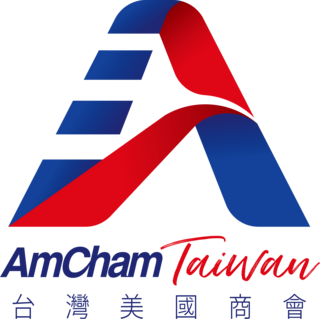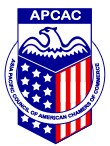
A chamber of commerce, or board of trade, is a form of business network. For example, a local organization of businesses whose goal is to further the interests of businesses. Business owners in towns and cities form these local societies to advocate on behalf of the business community. Local businesses are members, and they elect a board of directors or executive council to set policy for the chamber. The board or council then hires a President, CEO, or Executive Director, plus staffing appropriate to size, to run the organization.

The American Chamber of Commerce in Taiwan is an international business association based in Taipei City, Taiwan, with about 1,100 members representing over 580 companies across various sectors.

The Asia-Pacific Council of American Chambers of Commerce (APCAC) was formed in 1968. APCAC represents 50,000 business executives, 20,000 organizations in 22 countries within the Asia-Pacific region.

The National LGBT Chamber of Commerce (NGLCC) is a U.S. not-for-profit advocacy group that aims to expand the economic opportunities and advancement of the LGBT business community. Its headquarters are in NW in Washington, D.C. NGLCC is the exclusive certifying body for LGBT-owned businesses known as LGBT Business Enterprises (LGBTBEs), and advocates for LGBT business inclusion in corporate and government supplier diversity programs. In October 2017, the organization changed its name from the National Gay & Lesbian Chamber of Commerce to National LGBT Chamber of Commerce to better reflect the entire LGBT business community it serves.

The Australian Chamber of Commerce and Industry (ACCI) is Australia's largest and most representative business association, comprising state and territory chambers of commerce and national industry associations. ACCI represents Australian businesses of all shapes and sizes, across all sectors of the economy, and from every corner of the country.

Under the Basic Law, Macau's diplomatic relations and defence are the responsibility of the central government of China. Except diplomatic relations and defence, nonetheless, Macau has retained considerable autonomy in all aspects, including economic and commercial relations, customs control.
The American Chamber of Commerce to the European Union (AmCham EU) speaks for American business "committed to Europe on trade, investment and competitiveness issues. The stated mission of the organization is to ensure a growth-orientated business and investment climate in Europe. AmCham EU seeks to facilitate the resolution of transatlantic issues that impact business and plays a role in creating better understanding of EU and US positions on business matters. Aggregate US investment in Europe totaled more than €2 trillion in 2015, directly supports more than 4.3 million jobs in Europe, and generates billions of euros annually in income, trade and research and development."

The Hong Kong General Chamber of Commerce was founded on 29 May 1861, and is the oldest and one of the largest business organizations in Hong Kong. It has around 4,000 corporate members, who combined employ around one-third of Hong Kong's workforce. It is a self-funding, not-for-profit organization that promotes and represents the interests of the Hong Kong business community. A core function of its work is to formulate recommendations on improving the business environment, which its 23 industry-specific committees constantly analyze and make regular submissions to HKSAR Government officials and policy makers.
The Zimbabwe National Chamber of Commerce (The Chamber) is a private sector voluntary organization established in 1894 for The Chamber is established for the purpose of developing, promoting, and lobbying for its members and the local business community.

The American Chamber of Commerce (AmCham) is the leading foreign business organization operating in Russia. Founded in 1994, AmCham advocates the trade and investment interests of its member companies, which include major U.S. Corporations, as well as large European and Russian companies. The Chamber advances commercial relations between the Russian Federation and the international community by promoting an investment-friendly environment. In so doing, the Chamber maintains a constant dialogue with the Russian government to protect and promote the economic interests of member companies.

Robert W. Roche is an American entrepreneur and philanthropist active in the U.S., China and Japan.
The Canadian Chamber of Commerce in Shanghai is a nonprofit organization and the only Canadian chamber of commerce in China. Its mission is to support Canadian businesses in East China by helping businesses develop their networks and marketing opportunities as well as to cultivate a thriving Canadian community in Shanghai. The Canadian Chamber of Commerce in Shanghai is located at the Jing`An Kerry Centre in the Jing`An district of Shanghai. The Canadian Chamber of Commerce is led by 12 member board of directors. The Executive Director and the staff of the Chamber are responsible for the daily operations of the Chamber. Matt Whately is the current Executive Director.
The Benelux Chamber of Commerce (BenCham) is a Benelux non-profit organisation representing the interests of Benelux companies in China. BenCham strives to strengthen business, government and community ties between Benelux organisations and individuals in China. The Benelux Chamber of Commerce’s main objective is to facilitate networking between its members, the Benelux Embassies and Chinese interest groups. They oversee a network of Benelux companies and professionals, helping them exchange views and experiences regarding doing business in China.
AmCham Libya attracts US companies to the Libyan market by creating an environment for business matchmaking.
The American Business Forum in Turkey is a business association and NGO, composed of 125 or more U.S. companies with operations in Turkey. It was founded in 2004 as an American Chamber of Commerce, and it is focused on promoting a positive business agenda and commercial environment in Turkey and on strengthening bilateral trade, investment, and relations between Turkey and the U.S. through committee activities, access, visibility, business services, and networking opportunities.

The American Chamber of Commerce in the People's Republic of China is a nonprofit, nongovernmental organization whose membership comprises 4,000 individuals from 900 companies operating across China. The chamber's mission is to help American companies succeed in China through advocacy, information, networking and business support services. The chamber provides information, networking opportunities, business support services, and advocacy to promote a mutually beneficial bilateral business environment for the U.S. and China.
Yangtze River Pharmaceutical Group is a Chinese multinational pharmaceutical corporation headquartered in Taizhou, Jiangsu Province in the People's Republic of China, and with its research headquarters in Shanghai. It is one of the Asia's largest pharmaceutical companies by revenues, and was listed in 2014 as being China's second largest pharmaceutical manufacturer, and leading company for technological and entrepreneurial innovation.
Hisham A. Fahmy an Association Executive.










